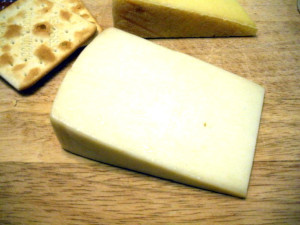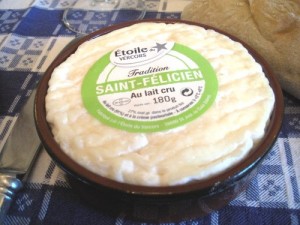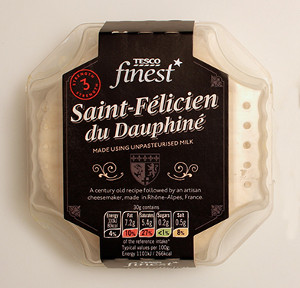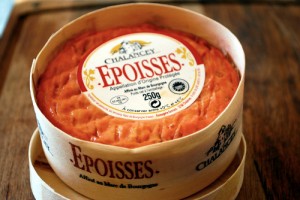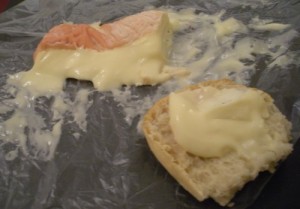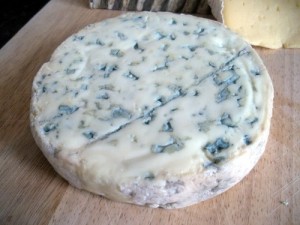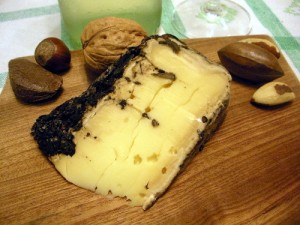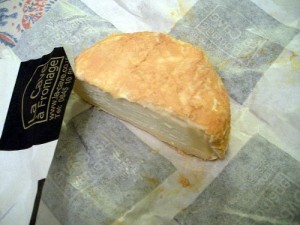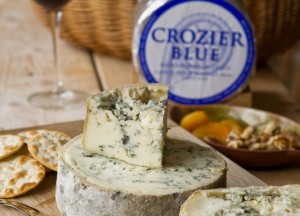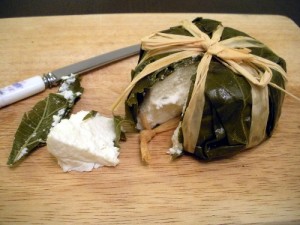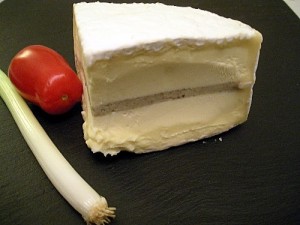Archive for the ‘4 Stars – Very Good’ Category
Sister Sarah
July 2nd, 2017 Posted 6:01 pm
Intolerant to cow’s milk, but don’t like goatiness? This is the cheese for you.
With its striking orange, annatto coloured rind and smooth, silky white pate this cheese is just so seductive.
Ahem… although it’s, normally… coated with annatto, (a bright orange natural colour, added to many orange cheeses, such as Red Leicester), the more astute reader may have noticed that our particular review piece is somewhat lacking in this feature..
Moving swiftly on, the pate is very white (ok, it’s not a good photo either), with an oily sheen and a mild milky smell.
The texture is deliciously soft and smooth, yielding sensually in the mouth.
Delicately milky and extremely satisfying. There’s a slight chalkiness and a very gently tangy spiciness that leaves a very, very subtle burning sensation, with hints of nuttiness and chocolate. Although this is a goat’s milk cheese, there is not even the slightest hint of goatiness.
It could be argued that the qualities of this cheese a so subtle that it could easily be dismissed as unremarkable. However, take the time to really taste and savour it and it becomes a very satisfying experience.
Produced by the High Weald Dairy
Purchased from Cheese Please, Lewes.
Reviewed by Nick & Olympia, 2014.




 (4/5)
(4/5)
Posted in 4 Stars - Very Good, English, Goat's milk, Hard
Saint Félicien
March 5th, 2017 Posted 7:58 pm
FREE! terracotta dish with every cheese!… well sometimes.
In France, it is traditional to sell Saint Félicien in shallow terracotta or eathenware dishes, although some manufacturers ship in shallow wooden boxes like a Camembert.
|
The reason for this is that the cheese is prone to becoming extremely runny and leaking whey. It also spoils easily if not allowed to breath. As a result, it doesn’t travel very well, which means it was quite difficult to get hold of. |
|
…and it is really very good. This normally fragile cheese is now easily available throughout the UK, its lush creaminess preserved for all enjoy. Yay!
Saint Félicien is officially categorised as an aged, fresh cheese, which basically means that it’s a couple of weeks old. The very soft yielding rind is a pale yellow, dusted with white mould. The smell is somewhat reminiscent of a freshly talcum powdered baby, sweet with a slight rancid background smell (cue the flood of e-mails from angry mothers). The pate can be almost liquid, requiring a spoon to serve and as it ages, it will also weep quite a lot of whey. Unsurprisingly, for a cheese that could probably be scientifically classified as a liquid, It has a deliciously smooth, creamy texture. The taste is delicate. Sour cream with a slightly fruity tang and nutty edge. As it ages, it will quickly start to become sour and bitter. After too long, it can become quite unpleasant. The trick is to catch it when it just starts to become runny and eat it within a week or two. |
Saint Félicien is one of those classic French cheeses that, until recently, was rarely spotted outside France. Now, thankfully, it has a regular spot on our cheeseboard.
Reviewed by Nick & Olympia, 2013.




 (4/5)
(4/5)
Posted in 4 Stars - Very Good, Cow's milk, French, Soft
Époisses
February 26th, 2017 Posted 8:10 pm
Époisses lays claim to being the smelliest cheese in the world. So smelly and offensive, that open carry is forbidden on the Paris Metro… apparently.
This is how it is presented in shops:
…however, unless you purchase the whole forme, this is how it will appear when you get it home:
The origins of this cheese date back to the 16th century and those naughty Trappist monks putting alcohol in everything. The cheese is washed with a mixture of brandy and brine. Though it is highly unlikely that the monks knew it at the time, a particular strain of bacteria (brevibacterium linens), notably responsible for smelly feet, was a key part of the recipe.
A popular cheese, it continued to be manufactured by many farms in the area. Then due to WW2, production ceased. The recipe was never recorded and only passed on from generation to generation through word of mouth.
Luckily, in 1956, the Berthauts, a couple of farmers near Dijon, had the foresight to revive the cheese and sought out the last surviving individuals who knew how to make it.
Époisses has a sticky orange rind. Did I mention, it’s also rather smelly? Maybe not as bad as expected by its claim of “the world’s smelliest cheese”, but certainly very pungent. Sweaty, smelly socks with a hint of slurry. It sounds horrible but to the hardened cheese connoisseur, it’s heaven (yes, we’re weird like that ![]() ). Sometimes, there is a strong smell of ammonia, but more about that in a moment.
). Sometimes, there is a strong smell of ammonia, but more about that in a moment.
The inner pate is a light creamy colour and should be soft and gooey or runny depending upon ripeness.
The texture is deliciously smooth and creamy and the flavour, perhaps surprisingly, is quite delicate. The pungent aromas are still present in the taste, but very subdued. There is also a wine reaction, that so often occurs with washed cheeses, in the form of delicious fruity notes that magically appear.
A note of warning. Éposses is one of those cheeses that really needs to be stored properly in order to get the best out of it. It is therefore, highly recommended that it be purchased from a proper fromagerie. Supermarkets do sell it, but very often it will lack the expected pungency and gooey decadence. Typically, supermarket sell-by dates are too short for refrigerated storage and the cheese is not fully ripe by the date indicated. In the opposite extreme, it can also become over-ripe and bitter, the aforementioned ammonia smell is a good indicator of this.
Époisses is a real classic cheese that is famous throughout the world. Don’t let bad supermarket experiences put you off, when this cheese is good, it is awesome.
Reviewed by Nick & Olympia, 2012




 (4/5)
(4/5)
Posted in 4 Stars - Very Good, Cow's milk, French, Soft, Washed
Fourme d’Ambert
January 29th, 2017 Posted 6:48 pm
Fourme d’Ambert is one of the oldest known cheeses, dating back to the Roman occupation of France, around 2,000 years ago. The recipe, that is, not the actual cheese which is normally only aged for a month or two.
Traditionally made in a cylindrical “fourme” (French Auvergnat dialect for mould) about 5½” (13cm) diameter and 7½” (19cm) tall, the wheel is unusually tall for its diameter. Usually, it is sold in slices across the wheel rather than wedges.
Soft and yielding, almost spreadable, dusted in a white/grey mould. The pate is off white to dark cream (depending upon age) and flecked with greenish blue. It’s a delightfully appealing cheese from the offset.
The smell is slight, almost non-existent. The texture is deliciously smooth and creamy, yielding pleasantly in the mouth. The flavour likewise is smooth and creamy, delicate with hints of blue. It could be described as similar to a very mellow Roquefort, not so sharp and a lot less salty.
It is a generally pleasant cheese, inoffensive and well behaved. A perfect blue addition to the cheeseboard when you might not want to overwhelm your guests.
Easily available from many supermarkets.
Reviewed by Nick & Olympia, 2011.




 (4/5)
(4/5)
Posted in 4 Stars - Very Good, Blue, Cow's milk, French, Semi-soft
Délice des Crémiers
January 22nd, 2017 Posted 8:04 pm
Rich, tangy, salty, triple cream decadence. A cheese to seriously clog the arteries.
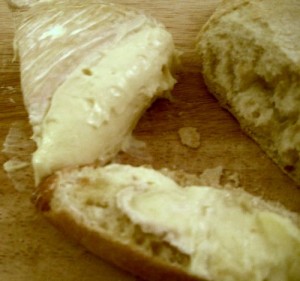 A small round soft cheese with a powdery white dusting of mould, sometimes presented in a simple round wood veneer box.
A small round soft cheese with a powdery white dusting of mould, sometimes presented in a simple round wood veneer box.
The rind smells sharp gathering hints of ammonia as it ages. The pate, soft with an ice cream like texture has the slight acidic smell of sour milk. As it ages the pate closest to the rind becomes soft and gooey separating the rind from the cheese within..
The soft pate melts in the mouth with an instant hit of a sharp, salty, but delicate flavour of sour milk. The flavour quickly fades yielding a softer and pleasing palate that must be savoured.
As it ages, the cheese becomes sharper and more acid, introducing a burn similar to blue cheeses.
All in all a very pleasant cheese, oozing decadence and luxury.
Reviewed by Nick & Olympia, 2012




 (4/5)
(4/5)
Posted in 4 Stars - Very Good, Cow's milk, French, Soft
Tomme au Marc de Rasin
October 25th, 2015 Posted 7:57 pm
It looks a bit like a rather old blackcurrant cheesecake that’s been sitting at the back of the fridge for far longer than it should have, but don’t be put off by its appearance.
|
Topped with the grape seeds and skins left over from wine making (otherwise known a marc). This cheese has a leathery black/grey/brown rind and a light golden waxy looking pate. Not surprisingly, it has the sweet, alcoholic smell of rotting fruit and sour milk. The texture is similar to that of Morbier, but more yielding, almost spreadable. The flavour is strong and robust but not overpowering with mildly alcoholic overtones (a bit like eating cheese with a sip of wine). All in all, a very pleasant cheese that’s a little different. Definitely one for the Christmas cheeseboard. |
Purchased from La Cave à Fromage, Hove.
Reviewed by Nick & Olympia, 2014




 (4/5)
(4/5)
Posted in 4 Stars - Very Good, Cow's milk, French, Hard, Unusual cheese
Tipsy Billy
February 3rd, 2015 Posted 7:21 pm
Specially commissioned by La Cave à Fromage, one could possibly guess from the name that this is a goat’s cheese washed in some sort of alcohol… and you would be correct (though we seriously hope that “Billy” is only a general reference to goat rather than specific).
This starts life as a basic unpasteurised goat’s cheese made in the West Midlands. Then La Cave à Fromage snatch it away from its innocence and imbibe it with cider matured in whiskey barrels. It is then locked away in a dark, cool room for three to four weeks.
The results is rather spectacular.
The orangey coloured rind is very wet and sticky, with whitish cream pate, that darkens toward the edges.
The smell is like a delicate reminder of the boys locker room at middle school. Sweaty, but without the pungency puberty brings.
The texture thick and creamy, but the flavour consists of a whole list of adjectives: sweet, fruity, tangy, sharp, salty, goaty and perfumy. The latter being enhanced with a sip of white wine.
In conclusion, a very complex, but highly enjoyable cheese. Definitely one worth trying.
Produced by La Cave à Fromage
Purchased from La Cave à Fromage, Brighton.
Reviewed by Nick & Olympia, 2013




 (4/5)
(4/5)
Posted in 4 Stars - Very Good, English, Goat's milk, Soft, Washed
Crozier Blue
December 14th, 2014 Posted 7:41 pm
| With a name like Crozier, you might expect this cheese to be French, but it is in fact, Irish. A crozier is a shepherd’s crook (Which is actually taken from the French word croisier, meaning cross bearer. A crosier, or crozier, is the staff with a cross or crook, that signifies an abbot or bishop. But, enough of that, this is a cheese blog, not an etymology class.)
Crozier is made by Cashel Farmhouse Cheesemakers and the name was chosen because the Rock of Cashel is where St. Patrick’s crozier is set in a statue… and this is a sheep’s milk cheese (you see what they did there? It has a thin grey, sticky rind and a sweaty, cream coloured pate with blue / grey veining. The smell is somewhat reminiscent of a schoolboy’s dirty kit bag. Sweaty, but lacking the pungency of masculine pheromones. However, don’t let this put you off. The texture is strangely grainy, like semolina pudding. The flavour salty and sharp with quite a bite and a subtle sweetness that creeps in. Usually blue cheeses are best when taken with sweeter wines, but this combination produces a peculiar metallic aftertaste. Maybe it’s the sweetness of the cheese, but a drier wine is much better. Having said all this, Crozier is a good cheese. It’s strange quirks make it an interesting addition to the cheeseboard. |
Produced by Cashel Farmhouse Cheesemakers.
Purchased from La Cave a Fromage, Brighton.
Reviewed by Nick & Olympia, 2014.




 (3/5)
(3/5)
Additional
A couple of weeks after purchase, it improved considerably. The texture became smoother and creamier and the flavour, much more mellow and satisfying. As a result, we had to re-evaluate our rating.




 (4/5)
(4/5)
Posted in 4 Stars - Very Good, Blue, Hard, Irish, Sheep's milk
Cerney Vine
August 25th, 2014 Posted 5:34 pm
| We came across this at the Sturminster Newton Cheese Festival. It was attracting a lot of attention. A sweet smelling, wet lump, wrapped in soggy vine leaves, then neatly tied up with a raffia bow… Oh, and it’s washed in Brandy… which could have had something to do with its popularity.
Opening the cellophane wrapper the first thing that you notice is how wet it is. It is seriously soggy. It smells sweet and fruity, like medlar fruit and capers. The paste is a brilliant white with the same sort of texture as a Ricotta. The flavour is clean, fresh and sharp. There are definite hints of alcohol and fruit, but it dissipates quickly, leaving you wondering if it was ever there in the first place. Unusually for a goat’s cheese, there is no goatiness whatsoever. All in all a very enjoyable cheese with a definite element of the unusual. |
Produced by Cerney Cheese
Purchased from The Sturminster Newton Cheese Festival
Reviewed by Nick & Olympia, 2013




 (4.5/5)
(4.5/5)
Posted in 4 Stars - Very Good, English, Goat's milk, Soft, Washed
Brillat-Savarin aux Truffes
March 16th, 2014 Posted 7:10 pm
Is it a cake? Is it a pudding? No, it’s super cheese… Brillat-Savarin aux Truffes! Aka: Brillat Truffé, Brillat aux Truffes, Brilliat-Savarin a la Truffe… to give it some of its other noms de plume. But regardless of what identity you may find it under, it’s still a super cheese.
Ordinary Brillat-Savarin is just a triple cream cheese. But whilst it may be utterly decadent creamy yumminess, it is just like pretty much any other soft, white, triple cream cheese. Explorateur, Délice de Bourgogne, Brillat-Savarin… they’re all very, very similar. Delicious, but similar.
THIS, on the other hand, takes it into a new realm of gastronomic indulgence. If Monsieur Brillat-Savarin, were to have smiled in his grave at the cheese named in his honour, this one would have him clawing his way out, just to try it.
It is a very tidy and well presented cheese. A perfect cylinder, delicately dusted in pure white mould. Cut to reveal a smooth, creamy interior with a neat grey/brown stripe running though its centre.
It has a typically soft buttery pate that smells mildly of truffle and… er… gear oil? The strong, earthy, truffle flavour is a perfect compliment to the sour, fresh taste of the cheese, dressed in the velvety, rich texture of triple cream.
This cheese is very special. A real Babette’s Feast experience.
Purchased from: La Cave à Fromage, Brighton.
Reviewed by: Nick & Olympia 2013.




 (4.5/5)
(4.5/5)
Posted in 4 Stars - Very Good, Cow's milk, Flavour added, French, Soft

